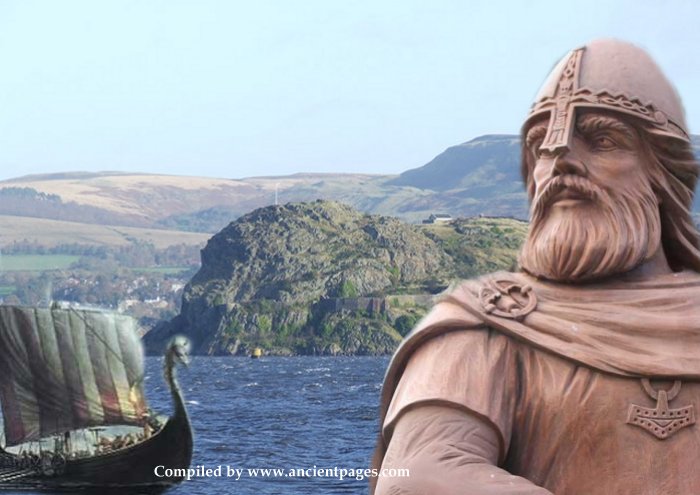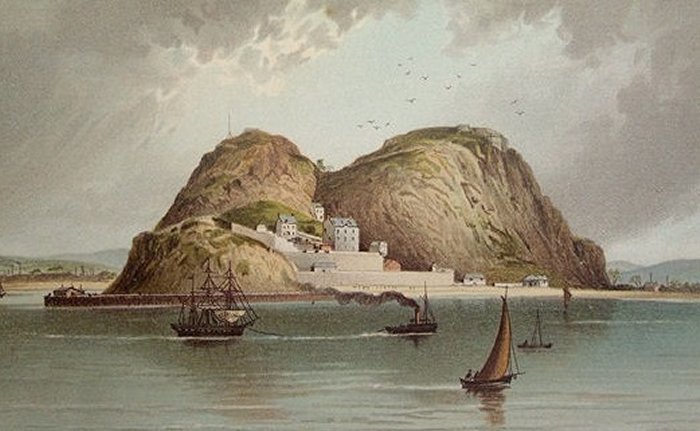Mystery Of Ivar The Boneless And Ímar – Remarkable Viking Puzzle Reveals Something Extraordinary
Ellen Lloyd - AncientPages.com - There are so many striking historical similarities between Ivar the Boneless and Ímar that some scholars suggest these two Vikings were the same person. If that is true, it's time to rewrite the history of Ivar the Boneless. Interestingly, Ímar vanished from the Irish historical records for unknown reasons at the same time Ivar the Boneless became active in England.
Could this fact possibly shed more light on the real identity of Viking Ímar? A closer examination of this historical Viking mystery reveals something extraordinary.
Viking Ímar (or Ívarr or Ivar) was the founder of the Uí Ímair dynasty, a Norse royal dynasty also known as the Dynasty of Ivar.
Being an influential Viking leader, Ímar ruled much of the Irish Sea region, the Norse Kingdom of Dublin, the western coast of Scotland, including the Hebrides, and some parts of Northern England, from the mid-9th century.
In the Fragmentary Annals of Ireland, it is written that Ímar was the son of Gofraid, King of Lochlann. We also learn from this text that Ímar had two brothers, Auisle and Amlaíb Conung. The Irish Annals also title the brothers Amlaíb, Ímar, and Auisle "kings of the foreigners" – not Irish kings but invaders.
Viking Halfdan Ragnarsson Was Brother Of Ivar the Boneless And Ímar
Turning our attention to Viking Ivar the Boneless, who we discussed in another article on Ancient Pages, we know that this enigmatic Viking was the leader of the Great Heathen Army, a coalition of Norse warriors originating from Denmark and Norway (and possibly also from Sweden). Some historians suggest Viking leader Halfdan Ragnarsson was also a brother of Ímar.
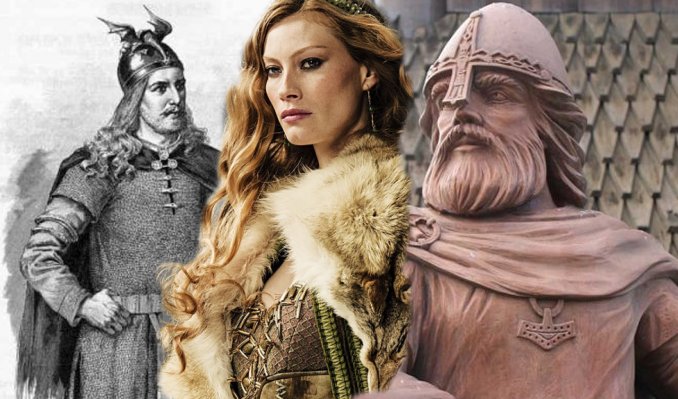
Ragnar Lodrok wanted to kill his son Ivar the Boneless against Aslaug's wishes. Read more:
They came together under a unified command.
Ivar the Boneless was the son of Ragnar Lodbrok, the fearless Sea King. Ragnar Lodrok considered himself to be a direct descendant of the god Odin and he was one of the most famous Norse heroes among the Vikings. His sons became just as renowned and heroic as he had been.
On one occasion, Lodbrok learned from a seer that he would have many famous sons. He became somewhat obsessed with this prophecy, which almost led to a tragic event when he tried to kill his son, Ivar the Boneless.
Ivar the Boneless survived his father's attempt to murder him and became one of the most famous Vikings in history.
From the Icelandic Sagas, we learn that Halfdan Ragnarsson, the brother of Ivar the Boneless. One reason to suspect that Ivar the Boneless was known in Ireland as Ímar!
Mysterious Disappearance Of Viking Ímar
During the late 850s and early 860s, Ímar became involved in a conflict with Máel Sechnaill, the Overking of the Southern Uí Néill and the most powerful ruler in Ireland.
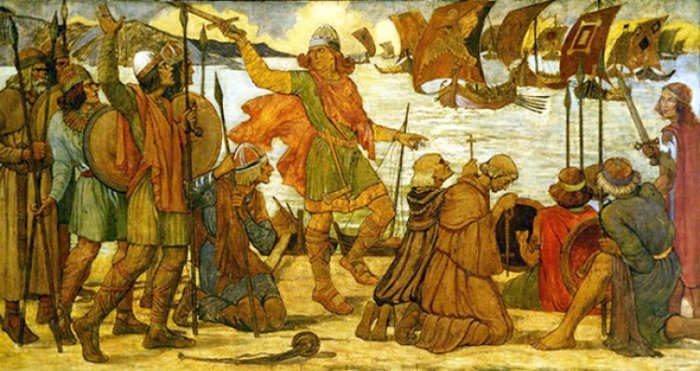 Artist's depiction of the landing of a Viking fleet at Dublin in 841 CE. Image credit: James Ward (1851-1924 - Public Domain
Artist's depiction of the landing of a Viking fleet at Dublin in 841 CE. Image credit: James Ward (1851-1924 - Public Domain
What really happened is unknown, but most likely, this was a struggle to gain control of Munster and its resources. In 862 AD, Máel Sechnaill died, and the conflict ended, dividing the lands of the dead Overking of the Southern Uí Néill.
Viking Ímar continued his battles and desired to expand the Norse kingdom. Then suddenly something strange happened. What happened, and where did he go? Ímar, the King of Dublin, vanished from the Irish historical records between 864 and 870 AD.
The story becomes even more interesting at this point because historical accounts state that in 865, Ivar the Boneless decided to invade England and launched the largest invasion of the British Isles in recorded history. His brothers Halfdan and Ubba and his colleague Olaf the White Ivar the Boneless sailed from Dublin and landed in East Anglia.
So, it's very likely that Ímar, Ivar the Boneless, sailed from Ireland to England, which is why he was not mentioned in Irish chronicles.
Dumbarton Rock. Illustration by T. Nelson (1892)
However, in the year 870 AD, Ímar reappeared in Irish records. According to the Irish annals, following a four-month-long siege, Ímar and Amlaíb captured Dumbarton Rock, the chief fortress of the kingdom of Strathclyde.
Both Vikings Ivar the Boneless and Ímar died in Ireland in 873 AD. Viking Ímar was given the title "King of the Norsemen of all Ireland and Britain" in contemporary annals.
Whose Descendants? Remarkable Viking Puzzle
Everything indicates Ivar the Boneless was known under a different name in Ireland. The similarities between these two Vikings are remarkable. They died the same year in the same country. They had a brother with the same name and made identical journeys, but unlike Ivar the Boneless, who historians suspect was impotent, Viking Ímar had descendants!
It means that there are two possibilities. Historians could be wrong in claiming that Ivar the Boneless was impotent, or, despite these similarities, we can assume that Ivar the Boneless and Ímar were two completely different persons who lived almost identical lives for some unknown reasons!
Updated on March 5, 2024
Written by - Ellen Lloyd – AncientPages.com
Copyright © AncientPages.com All rights reserved. This material may not be published, broadcast, rewritten or redistributed in whole or part without the express written permission of AncientPages.com
Expand for referencesMore From Ancient Pages
-
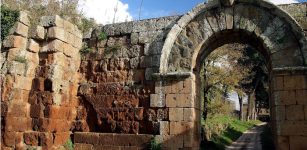 New Clues About The Fascinating Ancient Roman City Falerii Novi Revealed By Scientists
Archaeology | Sep 13, 2022
New Clues About The Fascinating Ancient Roman City Falerii Novi Revealed By Scientists
Archaeology | Sep 13, 2022 -
 Ancient City Filled With Treasures May Be Hidden Underground In South America
Featured Stories | Jul 20, 2018
Ancient City Filled With Treasures May Be Hidden Underground In South America
Featured Stories | Jul 20, 2018 -
 Goblins: Antisocial, Grotesque, Ugly And Vengeful Fairy Creatures In Ancient Beliefs
Featured Stories | Dec 6, 2018
Goblins: Antisocial, Grotesque, Ugly And Vengeful Fairy Creatures In Ancient Beliefs
Featured Stories | Dec 6, 2018 -
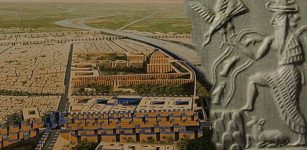 Eridu: Pre-Flood City That Belonged To Enki, God Of Creation, Intelligence, Wisdom And Magic
Civilizations | Mar 27, 2017
Eridu: Pre-Flood City That Belonged To Enki, God Of Creation, Intelligence, Wisdom And Magic
Civilizations | Mar 27, 2017 -
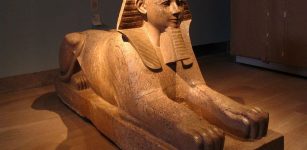 Why Was Pharaoh Hatshepsut’s Reign Virtually Erased From History?
Featured Stories | Nov 9, 2014
Why Was Pharaoh Hatshepsut’s Reign Virtually Erased From History?
Featured Stories | Nov 9, 2014 -
 Statue Of Apollo Discovered in Ancient City Of Prusias ad Hypium, Turkey
Archaeology | Aug 26, 2022
Statue Of Apollo Discovered in Ancient City Of Prusias ad Hypium, Turkey
Archaeology | Aug 26, 2022 -
 Heuneburg Early Celts’ Settlement: Wine Was Available To All Residents Not Only To Elite
Archaeology | Oct 25, 2019
Heuneburg Early Celts’ Settlement: Wine Was Available To All Residents Not Only To Elite
Archaeology | Oct 25, 2019 -
 Oldest Known Spearthrowers Found At 31,000-Year-Old Archaeological Site Of Maisières-Canal
Archaeology | Nov 6, 2023
Oldest Known Spearthrowers Found At 31,000-Year-Old Archaeological Site Of Maisières-Canal
Archaeology | Nov 6, 2023 -
 Powerful Ancient Maya Kaanu’l Dynasty And Their Intriguing Reliefs Of Mythical Animals And Celestial Ancestors In Quintana Roo, Mexico
Archaeology | Oct 23, 2024
Powerful Ancient Maya Kaanu’l Dynasty And Their Intriguing Reliefs Of Mythical Animals And Celestial Ancestors In Quintana Roo, Mexico
Archaeology | Oct 23, 2024 -
 The Face Of The Amarakarei – Remarkable Enormous Face Caved Into Stone Cliffs In Peru
Places | Nov 20, 2015
The Face Of The Amarakarei – Remarkable Enormous Face Caved Into Stone Cliffs In Peru
Places | Nov 20, 2015 -
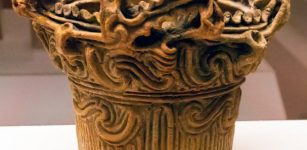 Surprising New Insights Into Use And Increased Production Of Pottery At The End Of The Last Ice Age
Archaeology | Mar 22, 2016
Surprising New Insights Into Use And Increased Production Of Pottery At The End Of The Last Ice Age
Archaeology | Mar 22, 2016 -
 Has A 12,000-Year-Old Underwater City Been Discovered Off The Coast Of Louisiana?
Archaeology | Mar 9, 2022
Has A 12,000-Year-Old Underwater City Been Discovered Off The Coast Of Louisiana?
Archaeology | Mar 9, 2022 -
 10 Remarkable Advanced Ancient Technologies Ahead Of Their Times
Ancient Technology | Jul 23, 2019
10 Remarkable Advanced Ancient Technologies Ahead Of Their Times
Ancient Technology | Jul 23, 2019 -
 Why Did First Printed Books Scare Ancient Scholars In Europe?
Ancient History Facts | Sep 18, 2021
Why Did First Printed Books Scare Ancient Scholars In Europe?
Ancient History Facts | Sep 18, 2021 -
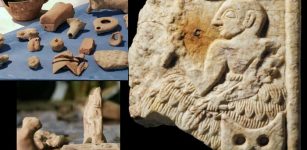 Hundreds Of Thousands Of Sumerian Artifacts Have Been Stolen From Iraq’s Museums And Archaeological Sites
Artifacts | Dec 7, 2020
Hundreds Of Thousands Of Sumerian Artifacts Have Been Stolen From Iraq’s Museums And Archaeological Sites
Artifacts | Dec 7, 2020 -
 4,500-Year-Old Row Of Giant Monoliths Found – Could Be the Largest In Britain
News | Sep 7, 2015
4,500-Year-Old Row Of Giant Monoliths Found – Could Be the Largest In Britain
News | Sep 7, 2015 -
 Forbidden Knowledge: Secret Ancient Gates Of The Shining Ones – Geomantic Energy Vortices – Part 2
Featured Stories | Jul 16, 2019
Forbidden Knowledge: Secret Ancient Gates Of The Shining Ones – Geomantic Energy Vortices – Part 2
Featured Stories | Jul 16, 2019 -
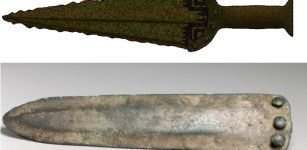 Scientists Can Finally Answer What Bronze Age Daggers Were Used For
Archaeology | Apr 29, 2022
Scientists Can Finally Answer What Bronze Age Daggers Were Used For
Archaeology | Apr 29, 2022 -
 Vikings Brewed Beer With Heated Stones – Old Tradition Popular In Germany, Finland And Baltic States
Archaeology | Dec 14, 2017
Vikings Brewed Beer With Heated Stones – Old Tradition Popular In Germany, Finland And Baltic States
Archaeology | Dec 14, 2017 -
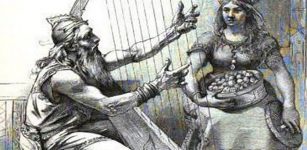 Bragi – Norse God Of Poetry, Eloquence, Music And Singing And Husband To Idun Who Protected Golden Apples
Featured Stories | Mar 17, 2018
Bragi – Norse God Of Poetry, Eloquence, Music And Singing And Husband To Idun Who Protected Golden Apples
Featured Stories | Mar 17, 2018

